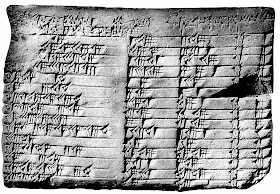The Region: Babylonia was name of the cultural region in the fertile crescent, stretching from the Persian Gulf to modern-day Baghdad and west to the Mediterranean Sea. Their history dates back as far as 4000 BCE with the Sumerians, though very little is known about the Sumerian culture.
The Babylonian civilization rose and fell for millenia, and their culture can be classified into several distinct periods. The mathematical records that have survived come from two different periods: the First Babylonian Dynasty period (1800s - 1500s BCE) and the Selucid period (400 - 0 BCE). Very few documents fall between those two periods. The main focus of researchers are documents from the First Babylonian Dynasty, but the second period is interesting because it overlaps with great mathematicians from Ancient Greece.
One particularly famous Babylonian was Hammurabi, the king of Babylon for much of the 18th century BCE. Hammurabi's Code is the oldest known form of constitution for a government, and the stone on which it is written is the longest surviving work from the Old Babylonian period.
The Numerals: The scholars of Babylonia used cuneiform numerals to write their numbers. They pressed the wedge-shaped end of a reed into soft clay, and hardened it into stone tablets. The numbers are written from left to right like modern Latin numerals, but that is where the similarities end.
Babylonian numerals use a Base-60 system. This sounds a little ridiculous- and we don't have an explicit reason for their system!- but there are a few intriguing theories as to why base-60 was used. One idea (and possibly the most accepted) is that the Babylonians combined two pre-existing number systems, one of base-5 and one of base-12.
Base-60 is, of course, a lot different from our system. I've made a chart below describing what each number would have looked like to the Babylonians:
 |
| Click on any image in the post to expand |
When the Babylonians wrote down numerals, they strung digits together just like we do with our decimal system. Here's what we do: after we've written 0 through 9, we've exhausted all of our digit symbols. So we write 1 and 0 together to signify ten. The 1 in "10" is in the 10s place- it signifies that there are ten sets of 1, plus whatever number comes behind it. Babylonians will write their digit for 1 in the 60s place.
After the 10s place, we have the 100s, 1000s, and so on. The sexagesimal system is different. They move from the 1s place to the 60s to the 3600s, and this continues with the powers of 60.
View a couple of samples of large cuneiform numbers below:
To convert Babylonian numerals to our decimal system, we must do a little bit of calculating. Follow along with the picture below. When we convert between sexagesimal and decimal, we multiply the digit in the ones place by 60 to the power of 0, or 1. Then, we multiply the digit in the 60s place by 60^1 and add to our first number. Then, multiply the digit in the 3600s place by 60^2 and add to our first two numbers. This continues until you've used all of your cuneiform digits. Here's a few examples:
The Math: Babylonians were able to utilize their sexagesimal system with great precision. They had symbols and expressions for basic mathematical functions, like addition and subtraction.
The Plimpton 322 Tablet (pictured at the top of the blog post) contained mathematics that suggests Babylonians had knowledge of Pythagorean triples. Does this imply that the Babylonians knew the Pythagorean Theorem long before Pythagorus? My history of math professor was certainly of this school of thought.
The Babylonians were also capable of expressing fractions. had a process for taking the mean of a set of numbers, had an approximation for pi, and and approximation for the square root of 2. For more precise information on the mathematical capabilities of the Babylonians, explore this paper.
The Problems: Like any writing system, Babylonian cuneiform has its drawbacks. The Babylonains did not have a concept of 0, or a numeral for 0. So what happened when a Babylonian scribe wanted to write a number such as 23,0,37?
It turns out they just left gaps between the place values. Most of the time, with context clues, this was no problem for the Babylonians. For example, who would want to sell 2, 0, 3 (in decimal, that's 7203) sheep instead of 2, 3 (decimal: 123)? The Babylonians got by, but it has made transcriptions much more difficult for modern historians.
___________________________________________________________________________
Next week, I'll be back with a post about an Ancient Chinese system of counting. Please leave a comment with any suggestions for counting systems to be featured in this series!
-Tori




No comments:
Post a Comment